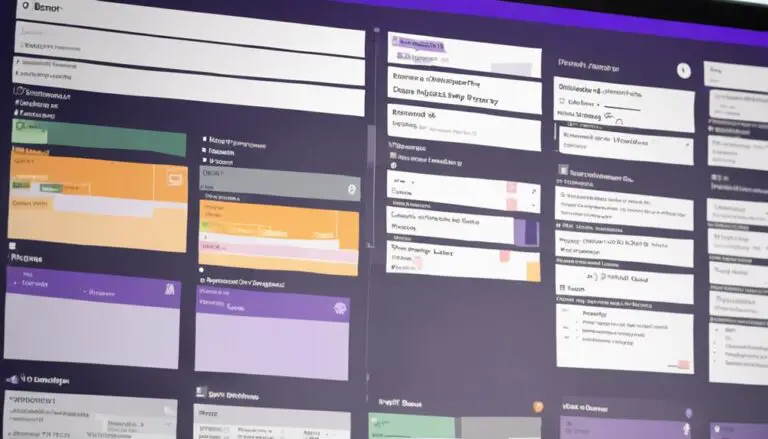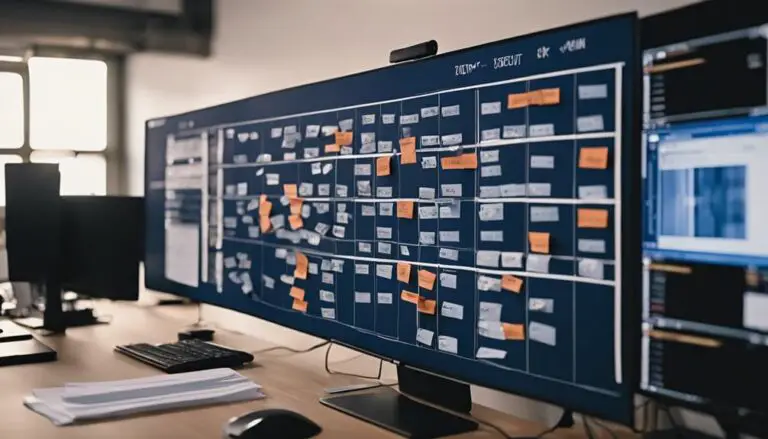You may have heard about stand-up meetings in Scrum, but have you ever wondered if Kanban has its own set of ceremonies?
The concept of rituals in Agile workflow goes beyond just daily check-ins. In this discussion, we'll explore how Kanban methodology incorporates ceremonies to enhance team dynamics and streamline processes. In Kanban, the most common ceremonies include the daily stand-up meetings, weekly backlog refinement sessions, and monthly retrospectives. These ceremonies provide opportunities for team members to communicate effectively, prioritize tasks, and reflect on their work. Successful kanban ceremony strategies focus on creating a collaborative and transparent environment where team members can openly discuss challenges and celebrate achievements. By consistently implementing these ceremonies, teams can improve their workflow and overall performance.
Stay tuned to uncover the hidden gems of rituals in Agile that could revolutionize your team's productivity and collaboration.
Key Takeaways
- Kanban practices include daily standup meetings and retrospectives for continuous improvement.
- Agile ceremonies in Kanban enhance collaboration, transparency, and workflow efficiency.
- Visual management in Kanban optimizes workflow and fosters a culture of teamwork.
- Implementing Kanban successfully involves understanding team dynamics and embracing adaptive planning.
Understanding Kanban Methodology
Curious about how Kanban methodology revolutionizes workflow management in agile teams?
Kanban, a method that emphasizes visualizing work and continuous improvement, offers a flexible approach to process improvement within Agile workflows. Unlike Scrum, Kanban doesn't have formal ceremonies but instead focuses on adapting rituals to suit the team's needs.
Daily standup meetings, replenishment sessions, and retrospective-like gatherings are some of the rituals that Kanban teams commonly engage in to enhance collaboration and efficiency.
Defining Agile Rituals
Agile rituals play a pivotal role in fostering collaboration and productivity within teams by structuring regular activities and ceremonies. Here are four key aspects to consider when defining Agile rituals:
- Structured Activities: Agile rituals, including Kanban ceremonies, provide a framework for teams to follow, ensuring a systematic approach to communication, planning, and reflection.
- Team Collaboration: These rituals promote teamwork by creating a shared understanding of goals, tasks, and progress, leading to enhanced collaboration among team members.
- Productivity: By establishing a cadence for communication and planning, Agile rituals help teams stay focused, organized, and efficient in their work processes.
- Continuous Improvement: Kanban rituals, such as daily standup meetings and retrospectives, emphasize the importance of learning from experiences, adapting to changes, and striving for continuous improvement in the Agile workflow.
Role of Ceremonies in Agile
Ceremonies within Agile frameworks like Kanban play a crucial role in enhancing collaboration, transparency, and iterative improvement in team workflows. These structured rituals aren't just mere formalities; they're the heartbeat of Agile methodologies, fostering a culture of teamwork and continuous learning.
Kanban ceremonies focus on ensuring continuous delivery, optimizing workflows, and engaging stakeholders to achieve project success. By incorporating these ceremonies, Kanban provides a framework for teams to reflect, plan, and refine their processes regularly.
Through ceremonies like daily stand-ups, sprint planning, reviews, and retrospectives, Agile teams promote open communication, identify bottlenecks, and adapt quickly to changes. This collaborative approach not only streamlines workflow but also empowers team members to take ownership of their tasks, driving efficiency and effectiveness.
Embracing Agile ceremonies in Kanban is key to aligning team goals, maintaining transparency, and ultimately delivering high-quality results through iterative improvements.
Exploring Kanban Practices
In exploring Kanban practices further, let's uncover the essence of its adaptive workflows and collaborative principles that drive continuous improvement within team dynamics. Kanban practices are designed to enhance team collaboration, improve workflow efficiency, and foster a culture of continuous learning and adaptation.
Here are four key practices that contribute to the success of Kanban teams:
- Daily Standup Meetings: These brief daily check-ins help team members synchronize their activities, share updates, and identify any potential blockers or challenges.
- Replenishment Meetings: By regularly reviewing and adjusting work priorities, teams ensure a steady flow of tasks and maintain focus on delivering value.
- Service Delivery Reviews: These sessions allow teams to reflect on completed work, gather feedback, and make necessary adjustments to enhance future delivery.
- Visualizing Work: Through visual management techniques like Kanban boards, teams can easily track progress, identify bottlenecks, and optimize their workflow for greater efficiency.
Significance of Agile Ceremonies
Let's explore the crucial significance of Agile ceremonies, such as those found in Kanban practices.
These ceremonies are essential for fostering collaboration, tracking progress, and continuously improving your team's workflow.
Agile Ritual Benefits
Enhancing team collaboration, communication, and productivity, Agile rituals in Kanban play a crucial role in fostering a culture of continuous improvement and learning within the team. Here are four benefits of Agile ceremonies in Kanban:
- Improved Team Collaboration: Agile rituals promote a shared understanding of project goals and foster a collaborative environment where team members work together effectively.
- Enhanced Communication: Regular ceremonies facilitate open communication channels, ensuring that information flows freely among team members, stakeholders, and clients.
- Increased Productivity: By promoting transparency and accountability, Agile rituals help in identifying bottlenecks, resolving issues promptly, and improving overall workflow efficiency.
- Continuous Learning: Kanban ceremonies encourage reflection and adaptation, allowing teams to learn from past experiences and make iterative improvements for better outcomes.
Ceremony Impact Analysis
As you analyze the impact of Agile ceremonies within your workflow, consider the profound significance these structured rituals hold in driving project success and enhancing team collaboration.
Agile ceremonies, such as Sprint Planning and Retrospectives, provide essential Kanban cadences that enable continuous improvement and risk mitigation. These structured frameworks offer quicker feedback loops, increased visibility, and improved collaboration among team members.
Studies show that Agile teams utilizing these ceremonies are 25% more productive, highlighting their importance in achieving project goals efficiently.
Impact on Team Collaboration
By incorporating Kanban ceremonies into your workflow, you can significantly boost team collaboration through structured meetings and continuous improvement practices. Here's how these practices can impact team collaboration positively:
- Enhanced Communication: Kanban ceremonies like Daily Standup and Replenishment Meetings provide regular opportunities for team members to communicate, share updates, and address any issues promptly, fostering better collaboration.
- Transparency and Coordination: Through Kanban ceremonies, team members gain transparency into project progress, task assignments, and bottlenecks, enabling improved coordination and alignment towards shared goals.
- Adaptability and Responsiveness: Kanban ceremonies emphasize adapting to changing project conditions and continuous improvement, encouraging team members to be responsive to evolving requirements, enhancing collaboration dynamics.
- Cultural Shift towards Improvement: By instilling a culture of continuous improvement and accountability, Kanban ceremonies create a supportive environment where team members are motivated to collaborate, innovate, and collectively strive for excellence in their workflow.
Optimizing Productivity in Agile
To enhance productivity in Agile workflows, consider incorporating Kanban principles and visual management techniques to streamline processes and optimize team efficiency effectively. Kanban, with its focus on continuous improvement, offers a framework that encourages teams to adapt and evolve iteratively.
By holding regular meetings like Daily Standups, teams can stay aligned, address any blockers promptly, and ensure smooth coordination among members. Visual management plays a crucial role in Kanban, aiding in workflow optimization by providing a clear, visual representation of tasks and their progress.
Backlog refinement sessions help prioritize work items, ensuring that the team is always working on tasks that deliver the most value. Additionally, conducting retrospective meetings allows teams to reflect on their processes, identify areas for improvement, and foster a culture of learning and adaptability.
Navigating Agile Workflow
Let's take a closer look at navigating the Agile workflow. Understanding the Agile rituals overview and team collaboration practices is key to optimizing your team's productivity.
Agile Rituals Overview
Explore the essential Agile rituals that streamline and enhance your workflow for optimal productivity and adaptability. When following Kanban principles, incorporating rituals can significantly boost your team's efficiency and effectiveness. Here are four key rituals to consider integrating into your workflow:
- Daily Standup Meetings: Quick check-ins to align on priorities, discuss progress, and highlight any blockers.
- Replenishment Meetings: Regular sessions to evaluate and adjust the work backlog, ensuring a steady flow of tasks.
- Service Delivery Reviews: Reflective meetings to assess completed work, gather feedback, and plan improvements.
- Optimizing Flow Efficiency: Constantly analyzing and refining processes to enhance workflow efficiency and identify areas for enhancement.
Team Collaboration Practices
Navigating Agile Workflow involves fostering a culture of open communication and shared responsibility among team members to enhance collaboration and drive continuous improvement. In Kanban practices, team collaboration thrives through regular meetings focusing on workflow, problem-solving, and enhancements.
Emphasizing incremental changes and adaptability, Kanban rituals aim to boost team performance. By promoting transparency, accountability, and effective communication, Kanban ceremonies optimize workflow efficiency. The primary objective is to cultivate a collaborative environment that delivers value to stakeholders.
Embrace the essence of Kanban practices by embracing teamwork, embracing continuous improvement, and fostering adaptability within your workflow. Through these practices, you can enhance team collaboration, drive workflow optimization, and achieve shared success.
Implementing Kanban Successfully
To implement Kanban successfully in your workflow, prioritize visualizing your team's processes and limiting work in progress to enhance efficiency. Here are four essential steps to help you achieve success:
- Understand Team Dynamics: Acknowledge the strengths and weaknesses of your team members to allocate tasks effectively and foster collaboration.
- Identify Workflow Bottlenecks: Pinpoint areas where work gets stuck or delayed to streamline processes and ensure a smooth workflow.
- Utilize Real-Time Data: Make data-driven decisions by leveraging real-time information to adapt and respond promptly to changing requirements.
- Embrace Adaptive Planning: Embrace flexibility in your planning process to accommodate evolving needs and promote continuous improvement within your workflow.
Frequently Asked Questions
How Is Kanban Different From Scrum Rituals?
In Kanban vs Scrum, Kanban's daily standups are more flexible than Scrum's time-boxed rituals like sprint planning. Backlog grooming and sprint reviews in Scrum offer structure; Kanban emphasizes continuous improvement through team collaboration and adaptability.
What Are 4 Agile Ceremonies?
In agile, you engage in vital ceremonies like daily standup for sync-ups, sprint planning for goal setting, backlog grooming for refinement, and sprint review for showcasing progress. Through continuous improvement and team collaboration, you thrive.
What Are the Five Major Rituals of an Agile Team?
In Agile teams, the five major rituals include Daily Standup, Sprint Planning, Backlog Grooming, Sprint Review. They foster team collaboration, task prioritization, continuous improvement, workflow optimization. Engage in these ceremonies to enhance alignment and progress for successful project delivery.
Is There a Retrospective in Kanban?
In Kanban, you engage in a retrospective meeting for team reflection, continuous improvement, process evaluation, and iterative review. It's a feedback loop for performance analysis, optimizing workflows, and fostering a culture of adaptability and enhancement.
Conclusion
As you reflect on the rituals and ceremonies in Kanban methodology, remember that every small change and review can lead to significant improvements in your team's workflow.
By embracing these Agile practices and fostering a culture of continuous learning and collaboration, you aren't just optimizing productivity, but also building stronger relationships with your stakeholders.
Keep navigating the Agile workflow with an open mind and a willingness to adapt, and you'll see the positive impact on your team's efficiency and satisfaction.





